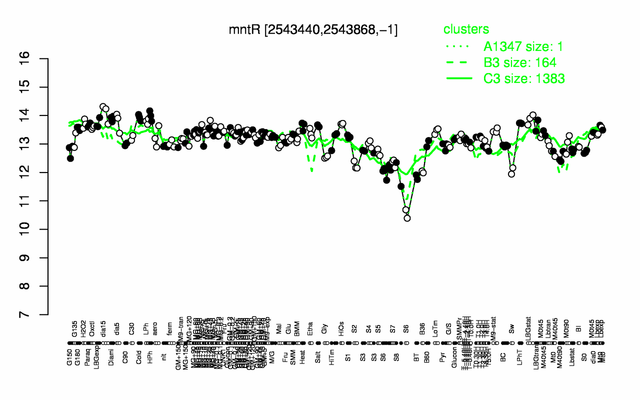MntR
Revision as of 14:10, 17 April 2014 by 134.76.70.252 (talk)
- Description: transcriptional regulator, (repression of mntH and mntA-mntB-mntC-mntD under high Mn(II) conditions)
| Gene name | mntR |
| Synonyms | yqhN |
| Essential | no |
| Product | transcriptional regulator (DtxR family) |
| Function | regulation of manganese transport |
| Gene expression levels in SubtiExpress: mntR | |
| Metabolic function and regulation of this protein in SubtiPathways: mntR | |
| MW, pI | 16 kDa, 5.631 |
| Gene length, protein length | 426 bp, 142 aa |
| Immediate neighbours | yqhO, lipM |
| Sequences | Protein DNA DNA_with_flanks |
Genetic context 
This image was kindly provided by SubtiList
| |
Expression at a glance PubMed
| |
Contents
Categories containing this gene/protein
trace metal homeostasis (Cu, Zn, Ni, Mn, Mo), transcription factors and their control, membrane proteins
This gene is a member of the following regulons
The MntR regulon:
The gene
Basic information
- Locus tag: BSU24520
Phenotypes of a mutant
Database entries
- BsubCyc: BSU24520
- DBTBS entry: no entry
- SubtiList entry: [1]
Additional information
The protein
Basic information/ Evolution
- Catalyzed reaction/ biological activity:
- Protein family:
- Paralogous protein(s):
Extended information on the protein
- Kinetic information:
- Domains:
- Modification:
- Cofactor(s): Mn(2+) acts as co-repressor (according to PubMed)
- Effectors of protein activity:
- Interactions:
- active as dimer (according to PubMed)
- Localization: cell membrane (according to Swiss-Prot)
Database entries
- BsubCyc: BSU24520
- UniProt: P54512
- KEGG entry: [2]
- E.C. number:
Additional information
Expression and regulation
- Operon:
- Sigma factor:
- Regulation:
- Regulatory mechanism:
- Additional information:
- number of protein molecules per cell (minimal medium with glucose and ammonium): 376 PubMed
- number of protein molecules per cell (complex medium with amino acids, without glucose): 790 PubMed
- number of protein molecules per cell (minimal medium with glucose and ammonium, exponential phase): 900 PubMed
- number of protein molecules per cell (minimal medium with glucose and ammonium, early stationary phase after glucose exhaustion): 300 PubMed
- number of protein molecules per cell (minimal medium with glucose and ammonium, late stationary phase after glucose exhaustion): 488 PubMed
Biological materials
- Mutant:
- Expression vector:
- lacZ fusion:
- GFP fusion:
- two-hybrid system:
- Antibody:
Labs working on this gene/protein
John Helmann, Cornell University, USA Homepage
Richard Brennan, Houston, Texas, USA Homepage
Your additional remarks
References
Reviews
Original Publications